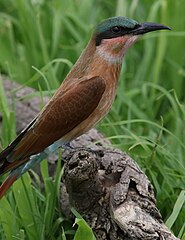bio.wikisort.org - Animal
The southern carmine bee-eater (Merops nubicoides) (formerly carmine bee-eater) occurs across sub-equatorial Africa.
This article needs additional citations for verification. (October 2019) |
Description
This species, like other bee-eaters, is richly coloured and is predominantly carmine in colouration, but the crown and undertail are blue.
Range and movements
The Southern carmine bee-eater occurs from KwaZulu-Natal and Namibia to Gabon, the eastern Democratic Republic of the Congo and Kenya. The bee-eater is a migratory species, spending the breeding season, between August and November, in Zimbabwe and Zambia, before moving as south as South Africa for the summer months, and then migrating to Equatorial Africa from March to August.
Diet and foraging
Their diet is made up primarily of bees and other flying insects, and their major hunting strategy involves hawking flying insects from perch. Perches may include branches of vegetation or even the backs of large animals, such as the kori bustard. They are attracted to wildfires because of the flushed insects, and are often seen circling high in the air. They circle larger animals and even cars to catch the insects that are trying to escape.
Habitat and breeding
Its usual habitat included low-altitude river valleys and floodplains, preferring vertical banks suitable for tunneling when breeding, but readily digging vertical burrows in the level surface of small salt islands. This is a highly sociable species, gathering in large flocks, in or out of breeding season. They roost communally in trees or reedbeds, and disperse widely during the day. Nesting is at the end of a 1 to 2 meter long burrow in an earthen bank, where they lay from 2 to 5 eggs.
Gallery
- Roosting in Phragmites reedbed
- Hunting over a kori bustard
- Hunting over a pair of ground hornbills
- Adult with juvenile
- Juvenile plumage
- Juvenile with Belonogaster wasp prey
References
This article includes a list of general references, but it lacks sufficient corresponding inline citations. (September 2010) |
- BirdLife International (2016). "Merops nubicoides". IUCN Red List of Threatened Species. 2016: e.T22683772A93000205. doi:10.2305/IUCN.UK.2016-3.RLTS.T22683772A93000205.en. Retrieved 11 November 2021.
- Roberts' Birds of Southern Africa - 6th edition (John Voelcker Fund, 1993) ISBN 0-620-17583-4
External links
- (Southern) Carmine Bee-eater - Species text in The Atlas of Southern African Birds.
На других языках
- [en] Southern carmine bee-eater
[fr] Guêpier carmin
Merops nubicoides[it] Merops nubicoides
Il gruccione carminio meridionale (Merops nubicoides Des Murs & Pucheran, 1846) è un uccello appartenente alla famiglia Meropidae[2] originario del continente africano.[ru] Карминная щурка
Карми́нная щу́рка (лат. Merops nubicoides) — вид птиц из семейства щурковые[1].Другой контент может иметь иную лицензию. Перед использованием материалов сайта WikiSort.org внимательно изучите правила лицензирования конкретных элементов наполнения сайта.
WikiSort.org - проект по пересортировке и дополнению контента Википедии









